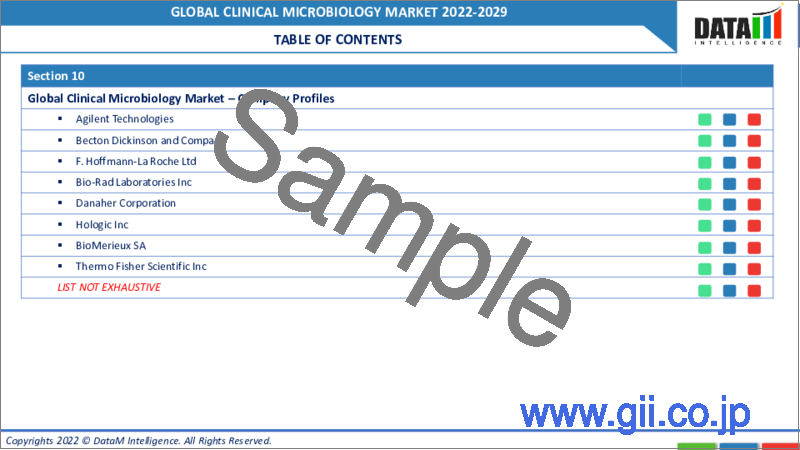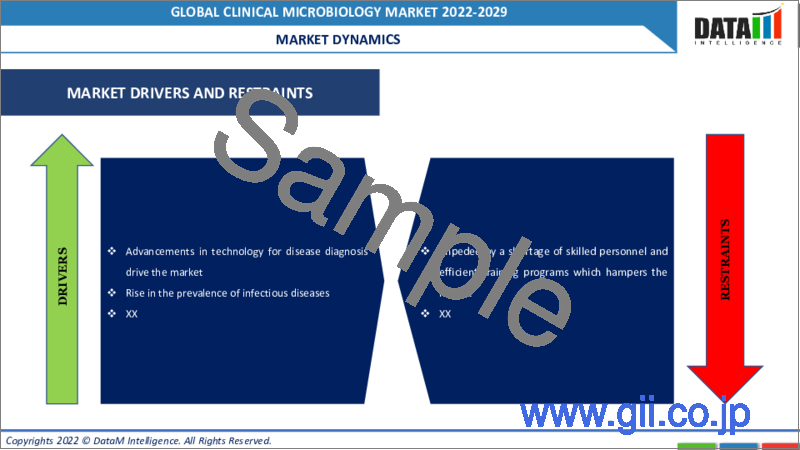|
|
市場調査レポート
商品コード
1138309
臨床マイクロバイオロジーの世界市場-2022-2029Global Clinical Microbiology Market - 2022-2029 |
||||||
|
● お客様のご希望に応じて、既存データの加工や未掲載情報(例:国別セグメント)の追加などの対応が可能です。 詳細はお問い合わせください。 |
|||||||
| 臨床マイクロバイオロジーの世界市場-2022-2029 |
|
出版日: 2022年10月18日
発行: DataM Intelligence
ページ情報: 英文 180 Pages
納期: 約2営業日
|
- 全表示
- 概要
- 目次
市場力学
世界の臨床マイクロバイオロジー市場の成長は、感染症の増加や人々の意識の高まりなど、特定の要因に牽引されています。
慢性疾患を分子レベルで理解し、治療ソリューションを開発する必要性の高まりにより、研究開発プログラムに資金を提供する組織が増え、予測期間中に市場を牽引することが予想されます。
米国疾病管理予防センター(CDC)によると、2020年には米国で結核の新規症例が約7860件、ライム病の新規症例が約3万件、髄膜炎菌病の新規症例が約375件登録されました。
同様に、米国癌協会によると、2021年に米国で新たに診断された癌の症例は約190万件です。このように、臨床検査が主要な診断ツールの1つとして使用される疾患の高い普及率は、将来的に市場の成長を増大させると予想されます。また、エボラ出血熱やジカ熱などの伝染性病原体の突発的な発生も、感染症の有病率上昇に寄与しています。Journal of Clinical Microbiologyに掲載された記事によると、サンプルや検体を処理し解釈するための訓練を受けた熟練した専門家が、医学研究所や微生物学研究所では不足しています。さらに、米国では医療検査技師養成プログラムの数や卒業する学生の数が急減しています。
高所得国が院内感染対策を強化する中、中・低所得国もその脅威を認識しています。自動化システムや革新的な設計の導入により、予測期間中に市場競争が激化し、市場力学が変化することが予想されます。この要因は、予測期間中の市場成長を促進しています。
世界保健機関(WHO)は、エチオピア、ブルキナファソ、ナイジェリア、アルジェリア、セネガルといった国々で特に活発に活動しており、HAIの発生率は2.5%から14.8%の間となっています。このため、これらの国々ではHAI診断薬に対する需要が高まっています。インド、スリランカ、パキスタン、ブータンなどの国も、HAI啓発プログラムに積極的に参加しています。インドと中国は、将来的にHAI診断機器と検査の需要を促進する主要な国になると予測されています。この要因も、予測期間中の市場成長を後押ししています。
同様に、診断ラボチェーンの統合や国民の意識向上といった要因も、市場の成長を後押ししています。新興国は、米国や欧州の国々を凌駕すると予想されます。これは主に、主要な病院チェーンが大都市に新しいセンターを開設するようになったことや、政府支出の増加によるものです。
微生物学的検査方法の償還不足が市場成長の妨げになる可能性が高い
しかし、インド、中国、中東やアフリカのその他の新興国など、対象となる患者数が多い国々では、臨床マイクロバイオロジー的検査手順が十分に償還されていないのが現状です。これは、患者や医療従事者の臨床微生物検査製品への嗜好を制限する大きな要因となっています。これは、プレミアム価格の臨床マイクロバイオロジー製品の採用に直接影響するため、予測期間中の市場成長にマイナスの影響を及ぼします。
COVID-19の影響分析
最近のCOVID-19パンデミックの発生は、検査機関がCOVID-19検査に忙殺され、他のすべての検査を停止しているため、市場の成長にマイナスの影響を及ぼしています。この要因は、予測期間中の市場成長を阻害することになるでしょう。
産業分析
世界の臨床マイクロバイオロジー市場は、ポーターのファイブフォース分析、サプライチェーン分析、規制分析、価格分析など、様々な産業要因に基づいた市場の詳細な分析を提供します。
世界の臨床マイクロバイオロジー市場レポートでは、約40以上の市場データ表、45以上の図、180ページの構成で提供しています。
目次
第1章 調査手法と調査範囲
- 調査手法
- 調査目的および調査範囲
第2章 市場の定義と概要
第3章 エグゼクティブサマリー
- 製品タイプ別市場内訳
- アプリケーション別市場内訳
- 地域別市場内訳
第4章 市場力学
- 市場影響要因
- 促進要因
- 感染症の増加
- 社会的認知度の向上
- 抑制要因
- 臨床微生物検査は、多くの国で十分な償還がされていません。
- 促進要因
- 影響分析
- ビジネスチャンス
第5章 産業分析
- ポーターのファイブフォース分析
- サプライチェーン分析
- 法規制分析
- 価格設定分析
- 製品分析
- ポストセールスサービス分析
第6章 製品タイプ別分析
- 試薬
- ラボラトリーインスツルメンツ
- インキュベーター
- グラムストレーナー
- バクテリアコロニーカウンター
- オートクレーブ滅菌器
- ペトリ皿充填機
- 自動培養システム
- 微生物検査装置
- 分子生物学的診断装置
- マイクロスコープ
- 質量分析計
第7章 アプリケーション別
- 呼吸器系疾患
- 血流感染症
- 消化器系疾患
- その他
第8章 地域別
- 北米
- 米国
- カナダ
- メキシコ
- 欧州
- ドイツ
- 英国
- フランス
- その他の欧州地域
- 南米
- ブラジル
- アルゼンチン
- その他の南米地域
- アジア太平洋地域
- 中国
- インド
- 日本
- オーストラリア
- その他アジア太平洋地域
- 中東・アフリカ地域
第9章 競合情勢
- 競合シナリオ
- 市況/シェア分析
- M&A(合併・買収)分析
第10章 企業プロファイル
- bioMerieux SA
- 企業概要
- 製品ポートフォリオと説明
- 主な発展状況
- 財務概要
- Danaher Corporation, Becton
- Dickinson and Company
- Abbott Laboratories
- Bio-Rad Laboratories, Inc
- , F. Hoffmann-La Roche AG
- Bruker Corporation
- Hologic, Inc.
- QIAGEN N.V.
- Thermo Fisher Scientific Inc.(*List is not exhaustive)
第11章 DataM
Market Overview
Clinical microbiology market size was valued at US$ 3.9 billion in 2021 and is estimated to reach US$ XX million by 2029, growing at a CAGR of 6.5% during the forecast period (2022-2029).
Clinical microbiology focuses on all aspects of patient infections from testing samples to identifying bacterial, viral, fungal, and parasitic agents that are contributing to the infectious process, determining the susceptibility of microorganisms to various antimicrobial agents, and reporting the results to healthcare providers.
The adaptation of microbiological techniques to the study of the etiological agents of infectious disease. Clinical microbiology determines the nature of the infectious disease and tests the ability of various antibiotics to inhibit or kill the isolated microorganisms. In addition to bacteriology, a contemporary clinical microbiologist is responsible for a wide range of microscopic and cultural studies in mycology, parasitology, and virology. The clinical microbiology is often the most competent person available to determine the nature and extent of hospital-acquired infections, as well as public-health problems that affect both the hospital and the community.
Market Dynamics
The global clinical microbiology market growth driven by certain factors such as by rise in infectious diseases, increase in public awareness are among the key factors driving the market growth.
Increasing need to understand chronic diseases at a molecular level and develop therapeutic solutions to encourage these organizations to fund research and development programs., is expected to drive the market during the forecast period
According to the Centers for Disease Control and Prevention (CDC), around 7860 new cases of tuberculosis, 30,000 new cases of Lyme disease, and 375 new cases of meningococcal disease were registered in the U.S. in 2020.
Similarly, according to the American Cancer Society, around 1.9 million new cases of cancer were diagnosed in the U.S. in 2021. Thus, the high prevalence of diseases where clinical tests are used as one of the major diagnostic tools is expected to augment market growth in the future. Sudden outbreaks of Ebola, Zika, and other contagious pathogens are also contributing to the rising prevalence of infectious diseases. As per an article published in the Journal of Clinical Microbiology, there is a shortage of trained and skilled professionals in medical and microbiological laboratories for processing and interpreting samples and specimens. Moreover, there has been a steep decline in the number of medical laboratory training programs and students graduating from such programs in the U.S.
As high-income countries are stepping up their pursuit of countering hospital-acquired infections, middle- and low-income countries are recognizing the threat. The introduction of automated systems and innovative designs is expected to intensify market competition and change market dynamics over the forecast period. This factor is driving the growth of the market in the forecast period.
The World Health Organization (WHO) is particularly active in countries such as Ethiopia, Burkina Faso, Nigeria, Algeria, and Senegal, where the occurrence of HAIs ranged between 2.5% and 14.8%. This has led to increased demand for HAI diagnostics in these countries. Countries such as India, Sri Lanka, Pakistan, and Bhutan are also actively participating in HAI awareness programs. India and China are projected to be the main countries driving demand for HAI diagnostics instruments and tests in the future. This factor is also driving the growth of the market in the forecast period.
Similarly, factors like the consolidation of diagnostic laboratory chains and the increase in public awareness are driving the growth of the market. The emerging countries are expected to outperform the U.S. and European countries. This is mainly due to the increase in the major hospital chains opening new centers in major cities as well as an increase in government expenditure.
Lack of reimbursement of microbiology testing procedures are likely to hamper the market growth
However, Clinical microbiology testing procedures are not adequately reimbursed across several countries such as India, China, and other emerging countries in the Middle East and Africa, which have a high target patient population base. This is a major factor that limits the preference for clinical microbiology products among patients and healthcare professionals. This directly affects the adoption of premium-priced clinical microbiology products, thereby negatively affecting their market growth in the forecast period.
COVID-19 Impact Analysis
The recent outbreak of the COVID-19 pandemic is negatively affecting the growth of the market as the laboratories are busy with the COVID-19 test which has halted all other tests. This factor will hinder the growth of the market in the forecast period.
Industry Analysis
The global clinical microbiology market provides in-depth analysis of the market based on various industry factors such as porter's five force analysis, supply chain analysis, regulatory analysis, pricing analysis etc.
Segment Analysis
The laboratory instruments segment is expected to grow at the fastest CAGR during the forecast period (2022-2029)
The global clinical microbiology market is segmented based on product type by laboratory instruments which are further sub-segmented into incubators, gram strainers, bacterial colony counters, autoclave sterilizers, petri dish fillers, and automated culture systems which is further sub-segmented into microbiology analyzers, molecular diagnostic instruments, microscopes, mass spectrometers, and reagents. The reagents segment held the largest market share. Factors such as the higher cost of specialized kits and constant repeat purchase are expected to drive the segment over the forecast period. A reagent s a substance or compound added to a system to cause a chemical reaction, or added to test if a reaction occurs. The importance of reagents will continue to outstrip supplies in many places as the race for safe and effective vaccines and treatment. A reagent may be used to tell whether or not a specific chemical substance is present by causing a reaction to occur with it.
The laboratory instruments segment is expected to have a positive market. Laboratories require a variety of equipment and consumables to perform tests and research activities. These are found in different types of laboratories such as research labs, clinical diagnostic labs, pathology labs, microbiology labs, educational labs, etc. to carry out research, scientific experiments, and execute analyses of different scientific materials.
It is estimated that the laboratory instrument segment is expected to witness significant growth over the forecast period, owing to technological advancements in the field of laboratory equipment, an increase in the number of clinical diagnostic procedures, and a rise in private & public healthcare investments. Besides, favorable insurance policies related to laboratory equipment further supplement the market growth. Furthermore, an increase in research related to life science and biotechnology boosts the laboratory instruments segment
Increasing chronic diseases such as chronic respiratory diseases, cardiovascular diseases, and diabetes, and increasing incidence of lifestyle diseases such as heart disease, obesity, atherosclerosis and hereditary diseases such as hemophilia, Down's syndrome, cystic fibrosis, and sickle cell anemia are leading to the increasing demand of laboratory equipment to bring innovative technologies in the market. According to the World Health Organization (WHO), the non-communicable disease leads to cause 40 million deaths each year, which is equivalent to 70% of all deaths worldwide. Cardiovascular diseases account for most of NCD mortality (17.7 million) annually, followed by cancer (8.8 million), respiratory disease (3.9 million), and diabetes (1.6 million). Thus, these factors will drive the growth of the market in the forecast period.
Further, the market is also classified based on application as respiratory diseases, bloodstream infections, gastrointestinal diseases, and others. The respiratory diseases segment is held the largest market share. The rise in prevalence of respiratory infectious diseases, such as Coronavirus diseases, MERS, chronic obstructive pulmonary disease, tuberculosis, pertussis, and influenza, is projected to drive the segment.
According to data published in January 2020, 2519 laboratory-conformed cases of Middle East respiratory syndrome (MERS), were reported, which includes 866 associated deaths globally. The majority of cases reported were from Saudi Arabia (2121 cases), including 788 related deaths with a higher fatality rate of 37.1%.
Moreover, the emergence of the COVID 19 pandemic has driven the segment. According to statistics, as of April 2020, there were around 3.45 million cases of COVID-19 globally, which drives the respiratory diseases segment. This factor will drive the growth of the market in the forecast period.
Geographical Analysis
North America region holds the largest market share of the global clinical microbiology market
North America dominated the global surgical glue market and is expected to grow at the highest CAGR during the forecast period due to an increase in the burden of COVID-19, well-developed health care infrastructure, and increasing prevalence of chronic obstructive pulmonary diseases, flu diseases, whooping cough, and other respiratory infections. This is anticipated to augment the Respiratory infectious disease treatment market in the region. COPD is considered to be the third-leading cause of death in the U.S., and the fourth-leading cause of death across the world. According to an article published on Very well Health, COPD affects around 11 million people in the U.S. and occurs in people over the age of 40. These statistics drive the demand for the treatment of respiratory infectious diseases. This factor will drive the growth of the market in the region.
Competitive Landscape
The global clinical microbiology market is highly competitive with the presence of several international and local markets. Product diversification, revenue generation, and opportunities intensify the market bioMerieux SA, Danaher Corporation, Becton, Dickinson and Company, Abbott Laboratories, Bio-Rad Laboratories, Inc, F. Hoffmann-La Roche AG, Bruker Corporation, Hologic, Inc., QIAGEN N.V., Thermo Fisher Scientific Inc. are the leading market players with significant market share.
Key Companies to Watch
Bio-Rad Laboratories
Overview: Bio-Rad Laboratories, Inc. is an American company that continued to produce innovative and useful products in the healthcare industry that assist life science researchers in accelerating the discovery process, and medical diagnostic labs obtain faster better results.
Product Portfolio: DC Protein Assay Reagents Package- Reagent pack for colorimetric assays, includes 250 ml alkaline copper tartrate, 2 L dilute Folin reagent, 5 ml surfactant solution; 450 assays.
The global clinical microbiology market report would provide an access to an approx. 40+ market data table, 45+ figures and 180 pages.
Table of Contents
1. Methodology and Scope
- 1.1. Research Methodology
- 1.2. Research Objective and Scope of the Report
2. Market Definition and Overview
3. Executive Summary
- 3.1. Market Snippet by Product Type
- 3.2. Market Snippet by Application
- 3.3. Market Snippet by Region
4. Market Dynamics
- 4.1. Market Impacting Factors
- 4.1.1. Drivers
- 4.1.1.1. A rise in infectious diseases
- 4.1.1.2. Increase in public awareness
- 4.1.2. Restraints
- 4.1.2.1. Clinical microbiology testing procedures are not adequately reimbursed across a number of countries
- 4.1.1. Drivers
- 4.2. Impact Analysis
- 4.3. Opportunity
5. Industry Analysis
- 5.1. Porter's Five Forces Analysis
- 5.2. Supply Chain Analysis
- 5.3. Regulatory Analysis
- 5.4. Pricing Analysis
- 5.5. Product Analysis
- 5.6. Post Sales Services Analysis
6. By Product Type
- 6.1. Introduction
- 6.2. Market Size Analysis, and Y-o-Y Growth Analysis (%), By Product Type
- 6.3. Market Attractiveness Index, By Product Type
- 6.3.1. Reagents *
- 6.3.1.1. Introduction
- 6.3.1.2. Market Size Analysis, US$ Mn, 2016-2025 and Y-o-Y Growth Analysis (%), 2020-2028
- 6.3.2. Laboratory Instruments
- 6.3.2.1. Incubators,
- 6.3.2.2. Gram strainers
- 6.3.2.3. Bacterial colony counters
- 6.3.2.4. Autoclave sterilizers
- 6.3.2.5. Petri dish fillers
- 6.3.3. Automated Culture Systems
- 6.3.3.1. Microbiology Analyzers
- 6.3.3.2. Molecular diagnostic instruments
- 6.3.3.3. Microscopes
- 6.3.3.4. Mass Spectrometers
- 6.3.1. Reagents *
7. By Application
- 7.1. Introduction
- 7.2. Market Size Analysis, and Y-o-Y Growth Analysis (%), By Application
- 7.3. Market Attractiveness Index, By Application
- 7.3.1. Respiratory Diseases
- 7.3.1.1. Introduction
- 7.3.1.2. Market Size Analysis, US$ Mn, 2016-2025 and Y-o-Y Growth Analysis (%), 2020-2028
- 7.3.2. Bloodstream Infections,
- 7.3.3. Gastrointestinal Diseases
- 7.3.4. Others
- 7.3.1. Respiratory Diseases
8. By Region
- 8.1. Introduction
- 8.2. Market Size Analysis, and Y-o-Y Growth Analysis (%), By Region
- 8.3. Market Attractiveness Index, By Region
- 8.4. North America
- 8.4.1. Introduction
- 8.4.2. Key Region-Specific Dynamics
- 8.4.3. Market Size Analysis, and Y-o-Y Growth Analysis (%), By Product Type
- 8.4.4. Market Size Analysis, and Y-o-Y Growth Analysis (%), By Application
- 8.4.5. Market Size Analysis, and Y-o-Y Growth Analysis (%), By Country
- 8.4.5.1. The U.S.
- 8.4.5.2. Canada
- 8.4.5.3. Mexico
- 8.5. Europe
- 8.5.1. Introduction
- 8.5.2. Key Region-Specific Dynamics
- 8.5.3. Market Size Analysis, and Y-o-Y Growth Analysis (%), By Product Type
- 8.5.4. Market Size Analysis, and Y-o-Y Growth Analysis (%), By Application
- 8.5.5. Market Size Analysis, and Y-o-Y Growth Analysis (%), By Country
- 8.5.5.1. Germany
- 8.5.5.2. The U.K.
- 8.5.5.3. France
- 8.5.5.4. Rest of Europe
- 8.6. South America
- 8.6.1. Introduction
- 8.6.2. Key Region-Specific Dynamics
- 8.6.3. Market Size Analysis, and Y-o-Y Growth Analysis (%), By Product Type
- 8.6.4. Market Size Analysis, and Y-o-Y Growth Analysis (%), By Application
- 8.6.5. Market Size Analysis, and Y-o-Y Growth Analysis (%), By Country
- 8.6.5.1. Brazil
- 8.6.5.2. Argentina
- 8.6.5.3. Rest of South America
- 8.7. Asia Pacific
- 8.7.1. Introduction
- 8.7.2. Key Region-Specific Dynamics
- 8.7.3. Market Size Analysis, and Y-o-Y Growth Analysis (%), By Product Type
- 8.7.4. Market Size Analysis, and Y-o-Y Growth Analysis (%), By Application
- 8.7.5. Market Size Analysis, and Y-o-Y Growth Analysis (%), By Country
- 8.7.5.1. China
- 8.7.5.2. India
- 8.7.5.3. Japan
- 8.7.5.4. Australia
- 8.7.5.5. Rest of Asia Pacific
- 8.8. The Middle East and Africa
- 8.8.1. Introduction
- 8.8.2. Key Region-Specific Dynamics
- 8.8.3. Market Size Analysis, and Y-o-Y Growth Analysis (%), By Product Type
- 8.8.4. Market Size Analysis, and Y-o-Y Growth Analysis (%), By Application
9. Competitive Landscape
- 9.1. Competitive Scenario
- 9.2. Market Positioning/Share Analysis
- 9.3. Mergers and Acquisitions Analysis
10. Company Profiles
- 10.1. bioMerieux SA*
- 10.1.1. Company Overview
- 10.1.2. Product Portfolio and Description
- 10.1.3. Key Developments
- 10.1.4. Financial Overview
- 10.2. Danaher Corporation, Becton
- 10.3. Dickinson and Company
- 10.4. Abbott Laboratories
- 10.5. Bio-Rad Laboratories, Inc
- 10.6. , F. Hoffmann-La Roche AG
- 10.7. Bruker Corporation
- 10.8. Hologic, Inc.
- 10.9. QIAGEN N.V.
- 10.10. Thermo Fisher Scientific Inc. (*List is not exhaustive)
11. DataM Intelligence
- 11.1. Appendix
- 11.2. About Us and Services
- 11.3. Contact Us




